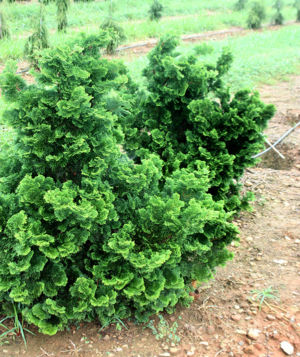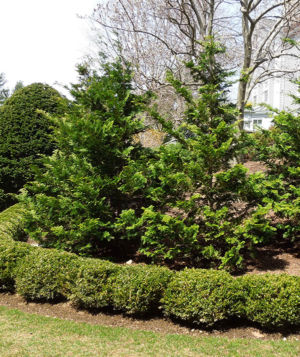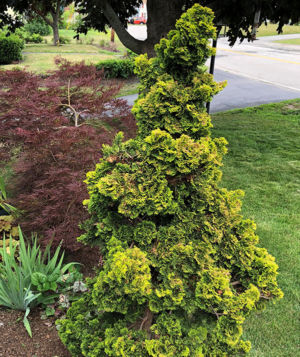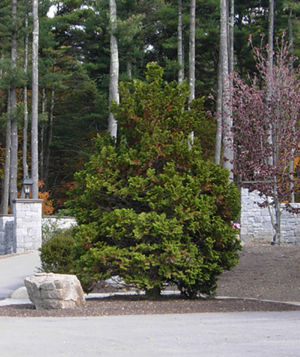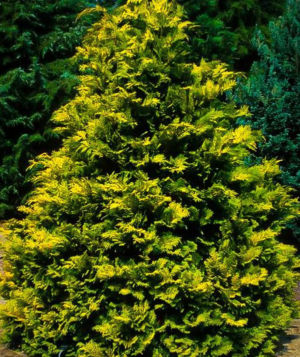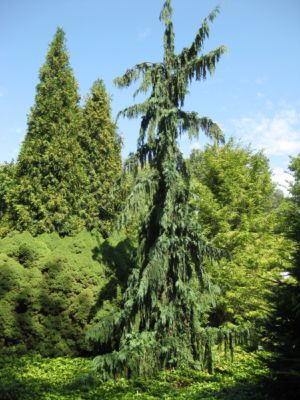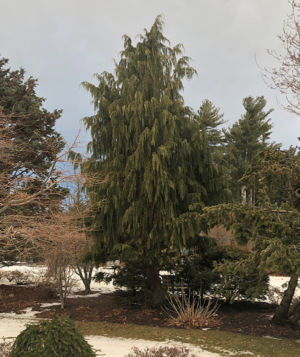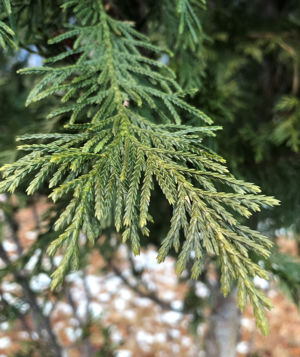Hinoki Falsecypress – Chamaecyparis obtusa
Description
General: The species, C. obtusa is native to Japan and can obtain heights up to 160 ft in its natural environment. There are many cultivars in all shapes and sizes that can surely fit their way into any landscape.
Leaves: Except for certain varieties, leaves are shiny dark green with small whitish markings beneath. Many varieties’ foliage exhibits fan-like appearance. May turn brownish in winter months.
Cones: Deep bluish- purple, 2-3″ long, 1″ wide. A striking contrast to the deep green foliage.
Flowers: Inconspicuous
Fruit: Small globuse cones about the size of a marble.
Bark: Reddish-brown in color and sheds in long narrow strips
Attributes: Cultivars such as ‘Well’s Special’, ‘Kosteri’, and ‘Gracilis Compacta’ can all be used as excellent specimen evergreens in the landscape. Other cultivars, such as ‘Chabo Yaderi’ or ‘Lycopodioides’ add textures. ‘Split Rock’ and ‘Crippsii’ add unique colors or a ‘Nana’ can be a nice addition to a rock garden. All make excellent choices for any landscape.
Culture
Growing Conditions: Prefers a moist, well-drained soil in a sunny to partially shady location. Protect from heavy drying winds.
Maintenance: Very little pruning necessary. For the most part, disease and insect free. Do not spray foliage with Bee/Wasp killer or plant injury, even death will occur.
Transplanting: Some books report them as hard to transplant, but we have not noticed that. We have had no problems transplanting various varieties at any time during the growing season.
Our Experience
Experience at Great Hill
Generally we do not see many issues with our Chamaecyparis that we have in the landscape. We have many varieties in a range of sizes. They provide beautiful year round interest with their size and texture.
Historical Winter Data
Winter 2016-17: We did have some winter injury on the tips of some of our Chamaecyparis this past winter. We think it might be related to the drought conditions of 2016, going into the winter with less water, compounded with drying winter winds. We pruned off the dead, dry branches. We did have some areas where the percentage loss of branches were to great and we removed the tree and replaced it with something else.
Winter 2017-18: No major injury to report, we did have some branches that broke under heavy snow loads in March, but were able to prune off the damage and salvage the remainder of the plants.
Alaskan Cedar – Chamaecyparis nootkatensis
Description
General: The species, C. nootkatensis is native to the coast of the Pacific Northwest, and while growing slow can obtain heights up to 90 ft in its natural environment. These tress are very long lived, some can survive for over a thousand years.
Leaves: Small, bluish-green, scale-like leaves.
Cones: Round, 1/2″ wide.
Fruit: Small globuse cones about the size of a marble.
Bark: Gray, loose peeling scales as it ages
Attributes: The cultivar ‘Pendula’ is probably more popular than the species in the landscape trade due to its interesting growth habit and drooping form. It is an excellent choice for a narrow location in the landscape.
Culture
Growing Conditions: Prefers a moist, well-drained soil in a sunny to partially shady location. Protect from heavy drying winds.
Maintenance: Very little pruning necessary. For the most part, disease and insect free. Do not spray foliage with Bee/Wasp killer or plant injury, even death will occur.
Transplanting: Some books report them as hard to transplant, but we have not noticed that. We have had no problems transplanting various varieties at any time during the growing season.
Our Experience
Experience at Great Hill
Generally we do not see many issues with our Chamaecyparis that we have in the landscape. We have many varieties in a range of sizes. They provide beautiful year round interest with their size and texture.
Historical Winter Data
Winter 2016-17: We did have some winter injury on the tips of some of our Chamaecyparis this past winter. We think it might be related to the drought conditions of 2016, going into the winter with less water, compounded with drying winter winds. We pruned off the dead, dry branches. We did have some areas where the percentage loss of branches were to great and we removed the tree and replaced it with something else.
Winter 2017-18: No major injury to report, we did have some branches that broke under heavy snow loads in March, but were able to prune off the damage and salvage the remainder of the plants.

